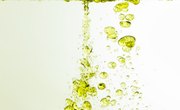
Lipids are a broad group of organic compounds that play important roles in living organisms, including cell membrane structure and chemical signals, and that are used to store energy. These compounds are typically insoluble in water, termed "hydrophobic," due to the large number of nonpolar bonds within their structures. Three common categories of lipids are triglycerides (fats and oils), diglycerides (phospholipids) and steroids.
Triglycerides
Triglycerides, commonly referred to as fats and oils, possess long chains of fatty acids attached to a glycerol group and serve as thermal insulation, energy storage for cells, and form protective layers for tissues and organs. The glycerol group contains three carbon atoms, with the fatty acid attached to each carbon. The fatty acids are long chains of hydrocarbons that are hydrophobic, making the resulting fat insoluble in water despite the hydrophilic nature of the glycerol. The fatty acids may be further characterized as saturated, monounsaturated or polyunsaturated, depending on the bonds between the carbon atoms in the fatty acid.
Saturated fatty acids have single bonds between all the carbon atoms and are thus saturated with the maximum number of possible hydrogen atoms. Monounsaturated fatty acids have a single double bond between two carbon atoms, producing a bend in the chain and reducing the number of hydrogen atoms compared to a saturated fatty acid. Polyunsaturated fatty acids have multiple double bonds between the carbon atoms of the fatty acid.
Diglycerides
Diglycerides, or phospholipids, consist of only two fatty acids attached to the glycerol group and a phosphate group attached to the third carbon atom of the glycerol. This arrangement of atoms produces a hydrophilic head on the molecule and two long hydrophobic tails. Phospholipids form the lipid bilayer of cell membranes, as the phospholipids on each membrane layer arrange themselves with the hydrophilic heads on the surface of the membrane and the hydrophilic tails form the interior of the membrane.
Steroids
Unlike triglycerides and diglycerides, steroids do not contain fatty acids. Instead, steroids are composed of four joined rings of carbon atoms with additional groups attached to the sides of the ring, depending on the specific steroid. Cholesterol is a frequently mentioned steroid that plays an important role in the body in the structure of cell membranes. It is also a precursor to the formation of hormones, including estrogen and testosterone, which also are steroids. However, high levels of LDL cholesterol can lead to plaque deposits in blood vessels and potentially to high blood pressure and heart attacks.
References
About the Author
David Chandler has been a freelance writer since 2006 whose work has appeared in various print and online publications. A former reconnaissance Marine, he is an active hiker, diver, kayaker, sailor and angler. He has traveled extensively and holds a bachelor's degree from the University of South Florida where he was educated in international studies and microbiology.
Photo Credits
extreme coloured egg's close-up image by Stasys Eidiejus from Fotolia.com
